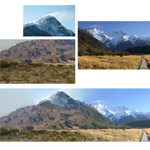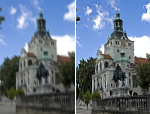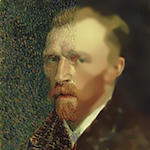
Content-Adaptive Image Downscaling
This paper introduces a novel content-adaptive image downscaling method. The key idea is to optimize the shape and locations of the downsampling kernels to better align with local image features. In comparison to previous downscaling algorithms, our results remain crisper without suffering from ringing artifacts.
Johannes Kopf, Microsoft Research Redmond
Ariel Shamir, Interdisciplinary Center, Herzliya
Pieter Peers, College Of William & Mary

"Mind the Gap'': Tele-Registration for Structure-Driven Image Completion
Given several non-overlapping image pieces sloppily pasted together with gaps between them, we perform a novel tele-registration method for aligning the pieces with respect to each other. Structure-driven image completion is then applied to fill the remaining gaps.
Hui Huang, Shenzhen Institute of Advanced Technology
Kangxue Yin, Shenzhen Institute of Advanced Technology
Minglun Gong, Memorial University
Dani Lischinski, The Hebrew University of Jerusalem
Daniel Cohen-Or, Tel Aviv University
Uri Ascher, University of British Columbia
Baoquan Chen, Shandong University

A No-Reference Metric for Evaluating The Quality of Motion Deblurring
We develop a no-reference perceptual metric for automatically comparing the quality of images produced by state-of-the-art deblurring algorithms. The metric is learned based on a massive user study, incorporates features that capture common deblurring artifacts, and does not require access to the original images.
Yiming Liu, Princeton University
Jue Wang, Adobe Research
Sunghyun Cho, Adobe Research
Adam Finkelstein, Princeton University
Szymon Rusinkiewicz, Princeton University

Structure-Preserving Image Smoothing via Region Covariances
We propose a novel image smoothing approach which depends on covariance matrices of image features, as known as the region covariances. Using region covariances allows to implicitly capture local structure and texture information, making our approach particularly effective for structure extraction from texture as compared to the state-of-the-art methods.
Levent Karacan, Hacettepe University
Erkut Erdem, Hacettepe University
Aykut Erdem, Hacettepe University






